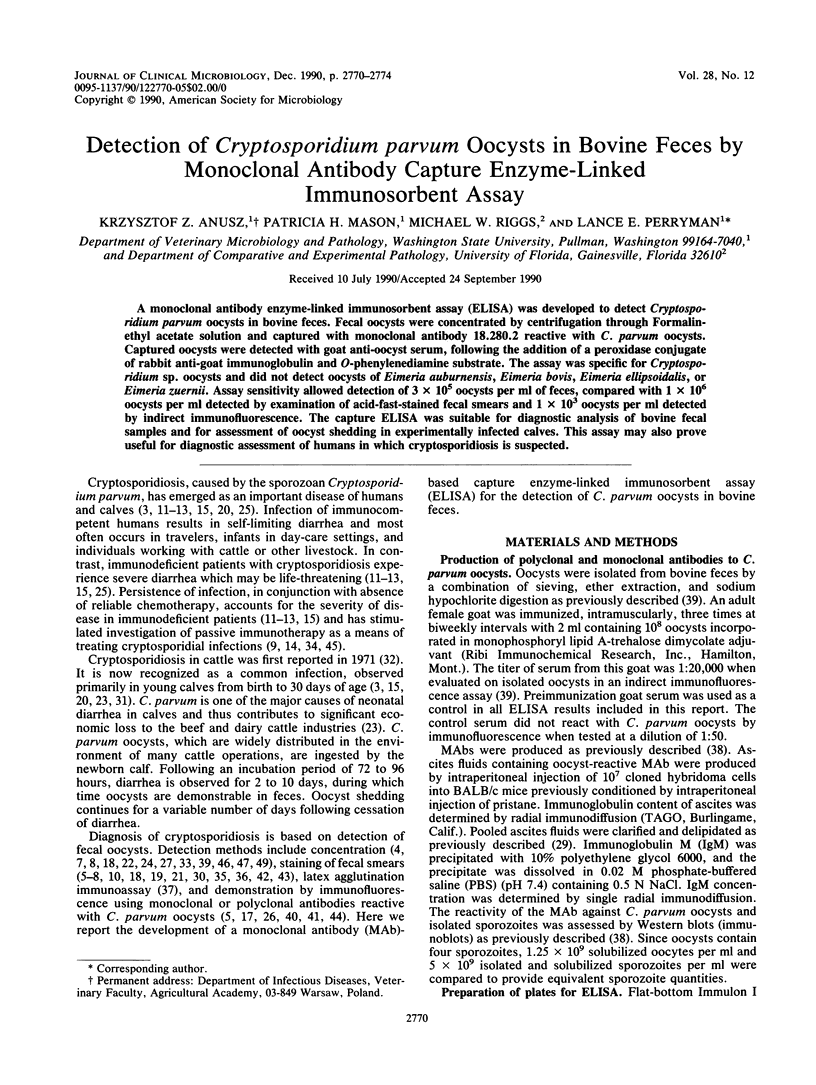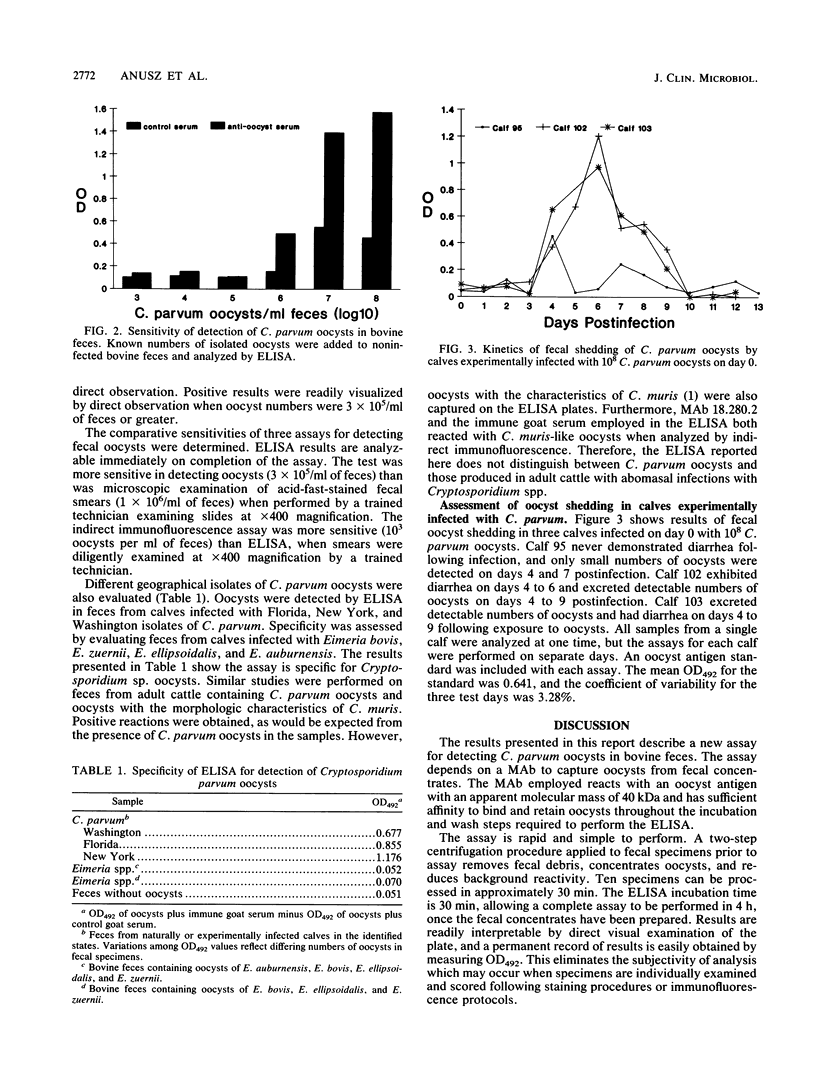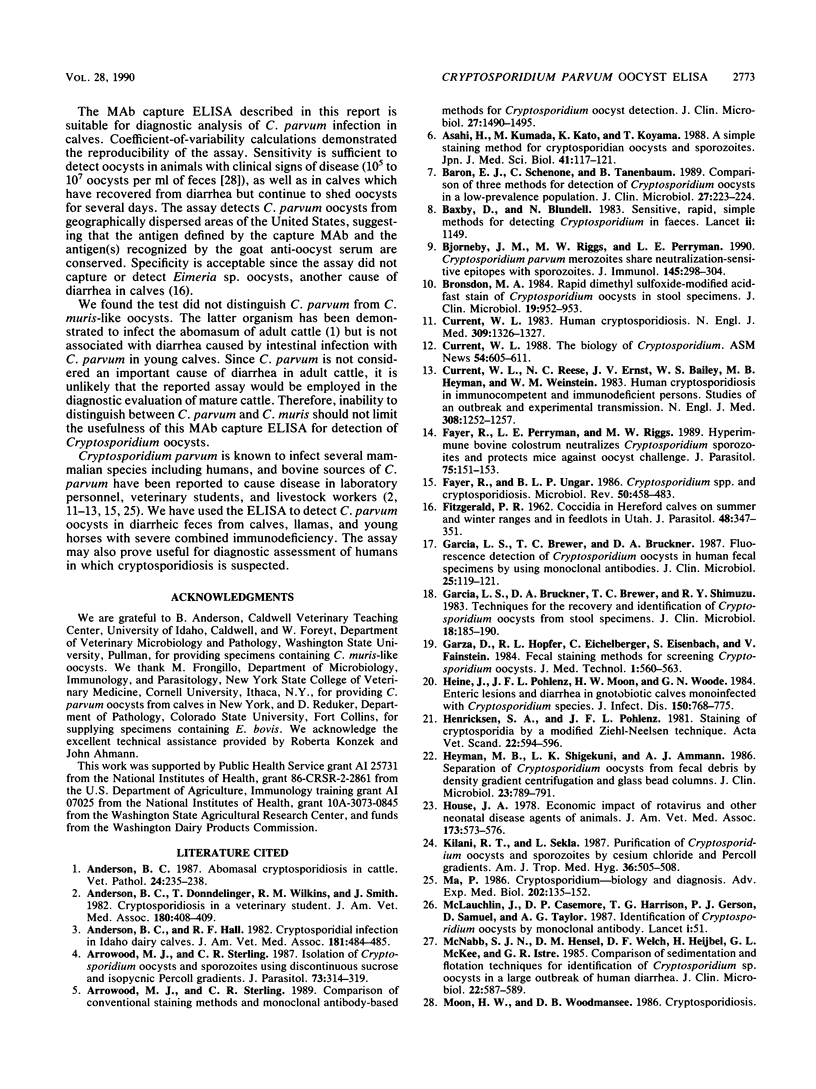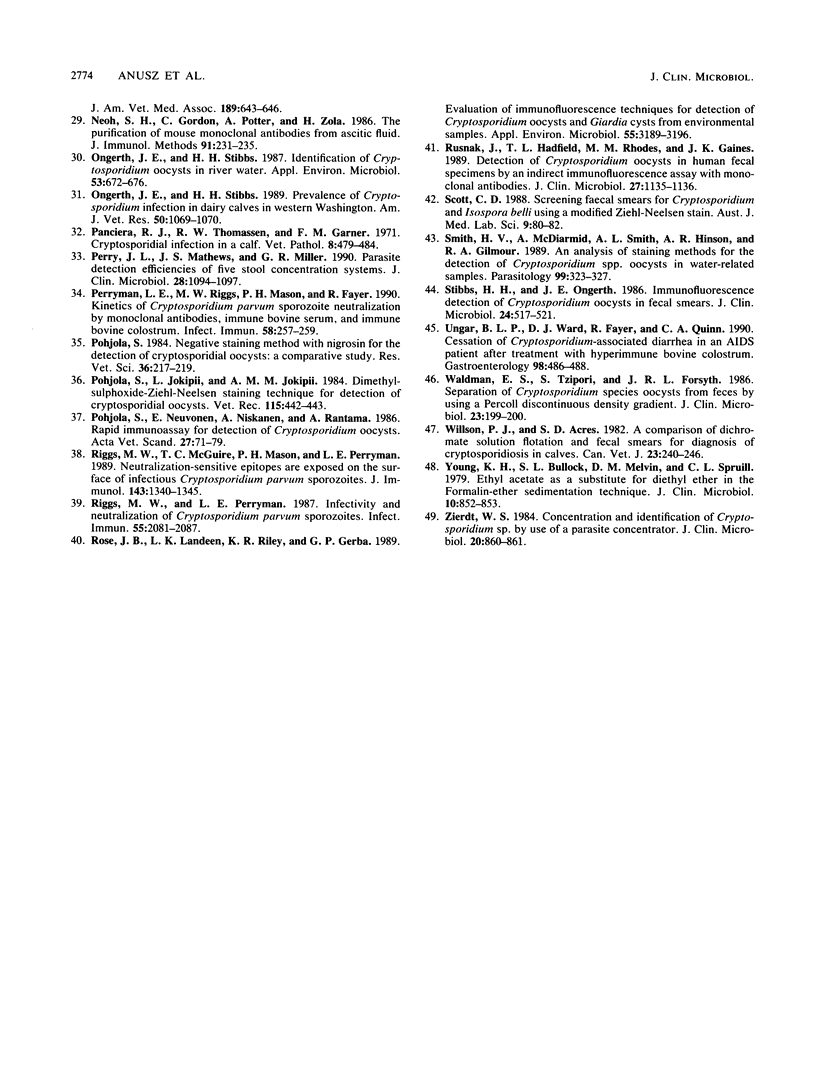Abstract
A monoclonal antibody enzyme-linked immunosorbent assay (ELISA) was developed to detect Cryptosporidium parvum oocysts in bovine feces. Fecal oocysts were concentrated by centrifugation through Formalin-ethyl acetate solution and captured with monoclonal antibody 18.280.2 reactive with C. parvum oocysts. Captured oocysts were detected with goat anti-oocyst serum, following the addition of a peroxidase conjugate of rabbit anti-goat immunoglobulin and O-phenylenediamine substrate. The assay was specific for Cryptosporidium sp. oocysts and did not detect oocysts of Eimeria auburnensis, Eimeria bovis, Eimeria ellipsoidalis, or Eimeria zuernii. Assay sensitivity allowed detection of 3 x 10(5) oocysts per ml of feces, compared with 1 x 10(6) oocysts per ml detected by examination of acid-fast-stained fecal smears and 1 x 10(3) oocysts per ml detected by indirect immunofluorescence. The capture ELISA was suitable for diagnostic analysis of bovine fecal samples and for assessment of oocyst shedding in experimentally infected calves. This assay may also prove useful for diagnostic assessment of humans in which cryptosporidiosis is suspected.
Full text
PDF




Images in this article
Selected References
These references are in PubMed. This may not be the complete list of references from this article.
- Anderson B. C. Abomasal cryptosporidiosis in cattle. Vet Pathol. 1987 May;24(3):235–238. doi: 10.1177/030098588702400307. [DOI] [PubMed] [Google Scholar]
- Anderson B. C., Donndelinger T., Wilkins R. M., Smith J. Cryptosporidiosis in a veterinary student. J Am Vet Med Assoc. 1982 Feb 15;180(4):408–409. [PubMed] [Google Scholar]
- Anderson B. C., Hall R. F. Cryptosporidial infection in Idaho dairy calves. J Am Vet Med Assoc. 1982 Sep 1;181(5):484–485. [PubMed] [Google Scholar]
- Arrowood M. J., Sterling C. R. Comparison of conventional staining methods and monoclonal antibody-based methods for Cryptosporidium oocyst detection. J Clin Microbiol. 1989 Jul;27(7):1490–1495. doi: 10.1128/jcm.27.7.1490-1495.1989. [DOI] [PMC free article] [PubMed] [Google Scholar]
- Arrowood M. J., Sterling C. R. Isolation of Cryptosporidium oocysts and sporozoites using discontinuous sucrose and isopycnic Percoll gradients. J Parasitol. 1987 Apr;73(2):314–319. [PubMed] [Google Scholar]
- Asahi H., Kumada M., Kato K., Koyama T. A simple staining method for cryptosporidian oocysts and sporozoites. Jpn J Med Sci Biol. 1988 Jun;41(3):117–121. doi: 10.7883/yoken1952.41.117. [DOI] [PubMed] [Google Scholar]
- Baron E. J., Schenone C., Tanenbaum B. Comparison of three methods for detection of Cryptosporidium oocysts in a low-prevalence population. J Clin Microbiol. 1989 Jan;27(1):223–224. doi: 10.1128/jcm.27.1.223-224.1989. [DOI] [PMC free article] [PubMed] [Google Scholar]
- Baxby D., Blundell N. Sensitive, rapid, simple methods for detecting Crysporidium in faeces. Lancet. 1983 Nov 12;2(8359):1149–1149. doi: 10.1016/s0140-6736(83)90669-4. [DOI] [PubMed] [Google Scholar]
- Bjorneby J. M., Riggs M. W., Perryman L. E. Cryptosporidium parvum merozoites share neutralization-sensitive epitopes with sporozoites. J Immunol. 1990 Jul 1;145(1):298–304. [PubMed] [Google Scholar]
- Bronsdon M. A. Rapid dimethyl sulfoxide-modified acid-fast stain of Cryptosporidium oocysts in stool specimens. J Clin Microbiol. 1984 Jun;19(6):952–953. doi: 10.1128/jcm.19.6.952-953.1984. [DOI] [PMC free article] [PubMed] [Google Scholar]
- Current W. L., Reese N. C., Ernst J. V., Bailey W. S., Heyman M. B., Weinstein W. M. Human cryptosporidiosis in immunocompetent and immunodeficient persons. Studies of an outbreak and experimental transmission. N Engl J Med. 1983 May 26;308(21):1252–1257. doi: 10.1056/NEJM198305263082102. [DOI] [PubMed] [Google Scholar]
- FITZGERALD P. R. Coccidia in Hereford calves on summer and winter ranges and infeedlots in Utah. J Parasitol. 1962 Jun;48:347–351. [PubMed] [Google Scholar]
- Fayer R., Perryman L. E., Riggs M. W. Hyperimmune bovine colostrum neutralizes Cryptosporidium sporozoites and protects mice against oocyst challenge. J Parasitol. 1989 Feb;75(1):151–153. [PubMed] [Google Scholar]
- Fayer R., Ungar B. L. Cryptosporidium spp. and cryptosporidiosis. Microbiol Rev. 1986 Dec;50(4):458–483. doi: 10.1128/mr.50.4.458-483.1986. [DOI] [PMC free article] [PubMed] [Google Scholar]
- Garcia L. S., Brewer T. C., Bruckner D. A. Fluorescence detection of Cryptosporidium oocysts in human fecal specimens by using monoclonal antibodies. J Clin Microbiol. 1987 Jan;25(1):119–121. doi: 10.1128/jcm.25.1.119-121.1987. [DOI] [PMC free article] [PubMed] [Google Scholar]
- Garcia L. S., Bruckner D. A., Brewer T. C., Shimizu R. Y. Techniques for the recovery and identification of Cryptosporidium oocysts from stool specimens. J Clin Microbiol. 1983 Jul;18(1):185–190. doi: 10.1128/jcm.18.1.185-190.1983. [DOI] [PMC free article] [PubMed] [Google Scholar]
- Heine J., Pohlenz J. F., Moon H. W., Woode G. N. Enteric lesions and diarrhea in gnotobiotic calves monoinfected with Cryptosporidium species. J Infect Dis. 1984 Nov;150(5):768–775. doi: 10.1093/infdis/150.5.768. [DOI] [PMC free article] [PubMed] [Google Scholar]
- Henriksen S. A., Pohlenz J. F. Staining of cryptosporidia by a modified Ziehl-Neelsen technique. Acta Vet Scand. 1981;22(3-4):594–596. doi: 10.1186/BF03548684. [DOI] [PMC free article] [PubMed] [Google Scholar]
- Heyman M. B., Shigekuni L. K., Ammann A. J. Separation of cryptosporidium oocysts from fecal debris by density gradient centrifugation and glass bead columns. J Clin Microbiol. 1986 Apr;23(4):789–791. doi: 10.1128/jcm.23.4.789-791.1986. [DOI] [PMC free article] [PubMed] [Google Scholar]
- House J. A. Economic impact of rotavirus and other neonatal disease agents of animals. J Am Vet Med Assoc. 1978 Sep 1;173(5 Pt 2):573–576. [PubMed] [Google Scholar]
- Kilani R. T., Sekla L. Purification of Cryptosporidium oocysts and sporozoites by cesium chloride and Percoll gradients. Am J Trop Med Hyg. 1987 May;36(3):505–508. doi: 10.4269/ajtmh.1987.36.505. [DOI] [PubMed] [Google Scholar]
- Ma P. Cryptosporidium--biology and diagnosis. Adv Exp Med Biol. 1986;202:135–152. doi: 10.1007/978-1-4684-1259-8_10. [DOI] [PubMed] [Google Scholar]
- McLauchlin J., Casemore D. P., Harrison T. G., Gerson P. J., Samuel D., Taylor A. G. Identification of cryptosporidium oocysts by monoclonal antibody. Lancet. 1987 Jan 3;1(8523):51–51. doi: 10.1016/s0140-6736(87)90753-7. [DOI] [PubMed] [Google Scholar]
- McNabb S. J., Hensel D. M., Welch D. F., Heijbel H., McKee G. L., Istre G. R. Comparison of sedimentation and flotation techniques for identification of Cryptosporidium sp. oocysts in a large outbreak of human diarrhea. J Clin Microbiol. 1985 Oct;22(4):587–589. doi: 10.1128/jcm.22.4.587-589.1985. [DOI] [PMC free article] [PubMed] [Google Scholar]
- Neoh S. H., Gordon C., Potter A., Zola H. The purification of mouse monoclonal antibodies from ascitic fluid. J Immunol Methods. 1986 Jul 24;91(2):231–235. doi: 10.1016/0022-1759(86)90483-7. [DOI] [PubMed] [Google Scholar]
- Ongerth J. E., Stibbs H. H. Identification of Cryptosporidium oocysts in river water. Appl Environ Microbiol. 1987 Apr;53(4):672–676. doi: 10.1128/aem.53.4.672-676.1987. [DOI] [PMC free article] [PubMed] [Google Scholar]
- Ongerth J. E., Stibbs H. H. Prevalence of Cryptosporidium infection in dairy calves in western Washington. Am J Vet Res. 1989 Jul;50(7):1069–1070. [PubMed] [Google Scholar]
- Perry J. L., Matthews J. S., Miller G. R. Parasite detection efficiencies of five stool concentration systems. J Clin Microbiol. 1990 Jun;28(6):1094–1097. doi: 10.1128/jcm.28.6.1094-1097.1990. [DOI] [PMC free article] [PubMed] [Google Scholar]
- Perryman L. E., Riggs M. W., Mason P. H., Fayer R. Kinetics of Cryptosporidium parvum sporozoite neutralization by monoclonal antibodies, immune bovine serum, and immune bovine colostrum. Infect Immun. 1990 Jan;58(1):257–259. doi: 10.1128/iai.58.1.257-259.1990. [DOI] [PMC free article] [PubMed] [Google Scholar]
- Pohjola S. Negative staining method with nigrosin for the detection of cryptosporidial oocysts: a comparative study. Res Vet Sci. 1984 Mar;36(2):217–219. [PubMed] [Google Scholar]
- Pohjola S., Neuvonen E., Niskanen A., Rantama A. Rapid immunoassay for detection of Cryptosporidium oocysts. Acta Vet Scand. 1986;27(1):71–79. doi: 10.1186/BF03548560. [DOI] [PMC free article] [PubMed] [Google Scholar]
- Riggs M. W., McGuire T. C., Mason P. H., Perryman L. E. Neutralization-sensitive epitopes are exposed on the surface of infectious Cryptosporidium parvum sporozoites. J Immunol. 1989 Aug 15;143(4):1340–1345. [PubMed] [Google Scholar]
- Riggs M. W., Perryman L. E. Infectivity and neutralization of Cryptosporidium parvum sporozoites. Infect Immun. 1987 Sep;55(9):2081–2087. doi: 10.1128/iai.55.9.2081-2087.1987. [DOI] [PMC free article] [PubMed] [Google Scholar]
- Rose J. B., Landeen L. K., Riley K. R., Gerba C. P. Evaluation of immunofluorescence techniques for detection of Cryptosporidium oocysts and Giardia cysts from environmental samples. Appl Environ Microbiol. 1989 Dec;55(12):3189–3196. doi: 10.1128/aem.55.12.3189-3196.1989. [DOI] [PMC free article] [PubMed] [Google Scholar]
- Rusnak J., Hadfield T. L., Rhodes M. M., Gaines J. K. Detection of Cryptosporidium oocysts in human fecal specimens by an indirect immunofluorescence assay with monoclonal antibodies. J Clin Microbiol. 1989 May;27(5):1135–1136. doi: 10.1128/jcm.27.5.1135-1136.1989. [DOI] [PMC free article] [PubMed] [Google Scholar]
- Smith H. V., McDiarmid A., Smith A. L., Hinson A. R., Gilmour R. A. An analysis of staining methods for the detection of Cryptosporidium spp. oocysts in water-related samples. Parasitology. 1989 Dec;99(Pt 3):323–327. doi: 10.1017/s0031182000059023. [DOI] [PubMed] [Google Scholar]
- Stibbs H. H., Ongerth J. E. Immunofluorescence detection of Cryptosporidium oocysts in fecal smears. J Clin Microbiol. 1986 Oct;24(4):517–521. doi: 10.1128/jcm.24.4.517-521.1986. [DOI] [PMC free article] [PubMed] [Google Scholar]
- Ungar B. L., Ward D. J., Fayer R., Quinn C. A. Cessation of Cryptosporidium-associated diarrhea in an acquired immunodeficiency syndrome patient after treatment with hyperimmune bovine colostrum. Gastroenterology. 1990 Feb;98(2):486–489. doi: 10.1016/0016-5085(90)90842-o. [DOI] [PubMed] [Google Scholar]
- Waldman E., Tzipori S., Forsyth J. R. Separation of Cryptosporidium species oocysts from feces by using a percoll discontinuous density gradient. J Clin Microbiol. 1986 Jan;23(1):199–200. doi: 10.1128/jcm.23.1.199-200.1986. [DOI] [PMC free article] [PubMed] [Google Scholar]
- Willson P. J., Acres S. D. A comparison of dichromate solution floatation and fecal smears for diagnosis of cryptosporidiosis in calves. Can Vet J. 1982 Aug;23(8):240–246. [PMC free article] [PubMed] [Google Scholar]
- Young K. H., Bullock S. L., Melvin D. M., Spruill C. L. Ethyl acetate as a substitute for diethyl ether in the formalin-ether sedimentation technique. J Clin Microbiol. 1979 Dec;10(6):852–853. doi: 10.1128/jcm.10.6.852-853.1979. [DOI] [PMC free article] [PubMed] [Google Scholar]
- Zierdt W. S. Concentration and identification of Cryptosporidium sp. by use of a parasite concentrator. J Clin Microbiol. 1984 Nov;20(5):860–861. doi: 10.1128/jcm.20.5.860-861.1984. [DOI] [PMC free article] [PubMed] [Google Scholar]



